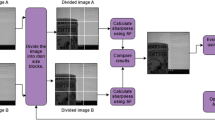Abstract
Three-dimensional information of objects is advantageous and widely used in multimedia systems and applications. Shape form focus (SFF) is a passive optical technique that reconstructs 3D shape of an object using a sequence of images with varying focus settings. In this paper, we propose an optimization of the focus measure. First, Wiener filter is applied for noise reduction from the image sequence. At the second stage, genetic algorithm (GA) is applied for focus measure optimization. GA finds the maximum focus measurement under a fitness criterion. Finally, 3D shape of the object is determined by maximizing focus measure along the optical direction. The proposed method is tested with image sequences of simulated and real objects. The performance of the proposed technique is analyzed through statistical criteria such as root mean square error (RMSE) and correlation. Comparative analysis shows the effectiveness of the proposed method.











Similar content being viewed by others
References
Ahmad M, Choi T (2005) A heuristic approach for finding best focused shape. IEEE Trans Circuits Syst Video Technol 15(4):566–574
Alberts B et al (2007) Molecular biology of the cell in cell 5th
Calumby R, da Silva Torres R, Gonçalves M (2012) Multimodal retrieval with relevance feedback based on genetic programming. Multimed Tools Appl. doi:10.1007/s11042-012-1152-7
Helmli F, Scherer S (2001) Adaptive shape from focus with an error estimation in light microscopy. In: Proceedings of the 2nd international symposium on image and signal processing and analysis, ISPA 2001. IEEE, pp 188–193
Jin F, Fieguth P, Winger L, Jernigan E (2003) Adaptive Wiener filtering of noisy images and image sequences. In: Proceedings International Conference on Image Processing, ICIP 2003, vol 3
Kondo K, Ichioka Y, Suzuki T (1977) Image restoration by Wiener filtering in the presence of signal-dependent noise. Appl Opt 16(9):2554–2558
Lee J (1980) Digital image enhancement and noise filtering by use of local statistics. IEEE Trans Pattern Anal Mach Intell 2:165–168
Lin W, Chen M (2012) A novel framework for automatic 3d face recognition using quality assessment. Multimed Tools Appl. doi:10.1007/s11042-012-1092-2
Malik A, Choi T (2007) Application of passive techniques for three dimensional cameras. IEEE Trans Consum Electron 53(2):258–264
Nayar S, Nakagawa Y (1990) Shape from focus: an effective approach for rough surfaces. In: IEEE international conference on proceedings robotics and automation, 1990, pp 218–225
Nayer S, Nakagawa Y (1994) Shape from focus. IEEE Trans Pattern Anal Mach Intell 16(8):824–831
Pham T (2001) An image restoration by fusion. Pattern Recogn 34(12):2403–2411
Subbarao M, Choi T (1995) Accurate recovery of three-dimensional shape from image focus. IEEE Trans Pattern Anal Mach Intell 17(3):266–274
Takahashi M, Fujii M, Naemura M, Satoh S (2013) Human gesture recognition system for tv viewing using time-of-flight camera. Multimed Tools Appl 62(3):761–783
Tenenbaum J (1971) Accommodation in computer vision
Vincent L (1992) Morphological grayscale reconstruction: definition, efficientalgorithm and applications in image analysis. In: Proceedings CVPR’92., IEEE computer society conference on computer vision and pattern recognition, pp 633–635
Vincent L (1993) Morphological area openings and closings for grey-scale images. Shape in picture: mathematical description of shape in grey-level images, pp 196–208
Vincent L (1993) Morphological grayscale reconstruction in image analysis: applications and efficient algorithms. IEEE Trans Image Process 2(2):176–201
Xie H, Rong W, Sun L (2006) Wavelet-based focus measure and 3-d surface reconstruction method for microscopy images. In: 2006 IEEE/RSJ international conference on intelligent robots and systems. IEEE, pp 229–234
Yoo H, Cho S (2007) Video scene retrieval with interactive genetic algorithm. Multimed Tools Appl 34(3):317–336
Zou K, Ip W, Wu C, Chen Z, Yung K, Chan C (2012) A novel 3d model retrieval approach using combined shape distribution. Multimed Tools Appl. doi:10.1007/s11042-012-1130-0
Acknowledgements
This research was supported by Basic Science Research Program through the National Research Foundation of Korea(NRF) funded by the Ministry of Education, Science and Technology(2012-0001344). This work (2012-0005542) was supported by the Mid-career Researcher Program through a National Research Foundation (NRF) grant funded by the Ministry of Education, Science and Technology (MEST), Korea.
Author information
Authors and Affiliations
Corresponding author
Rights and permissions
About this article
Cite this article
Lee, IH., Mahmood, M.T., Shim, SO. et al. Optimizing image focus for 3D shape recovery through genetic algorithm. Multimed Tools Appl 71, 247–262 (2014). https://doi.org/10.1007/s11042-013-1433-9
Published:
Issue Date:
DOI: https://doi.org/10.1007/s11042-013-1433-9




